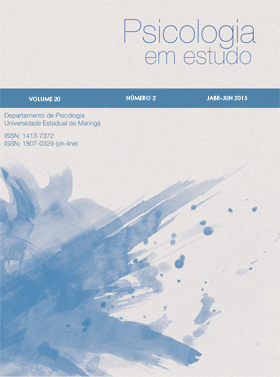CLINICAL DIMENSIONS OF THE ACT IN OBESITY: COMPULSION TO EAT AND SYMPTOM IN THE PSYCHOANALYTIC PERSPECTIVE
Abstract
Starting from the differentiation of clinical dimensions of the act, conceptualizing with Freud the symptomatic act, the acting out, the faulty act and the passage to the act, and the discussion of the idea of symptom, the present work tries to understand what is involved in compulsion to eat present in so-called obese patients. This differentiation aims to instruct a new way of understanding compulsion to eat with in the psychoanalytic field by following the Freudian developments in the second topic. In view of the advent of the concept of death drive in 1920, the lato sensu compulsion can no longer be considered only as a compromise formation, because in the case of so-called obese patients, the compulsion carries a satisfaction that goes beyond the pleasure principle. The differentiation between Neurosis and Psychosis is discussed using the idea of Ordinary Psychosis, which allows us to point out a possibility of ‘failure’ in the effect of barring the jouissance that is evidenced in the insistence of these symptoms that takes a secondary gain to which the subjects remain bounded. Compulsion to eat is therefore a way of avoiding the anxiety that paradoxically produces suffering, or an act that merges with the ego and charges its price with anxiety. It is suggested to advance the understanding of the last Freudian anxiety theory to distinguish the different ways of clinical approach of the act in its different declinations.
Downloads
References
Barros, R. R. (2002). Compulsões, desejo e gozo. Latusa, Rio de Janeiro: Escola Brasileira de Psicanálise, 7, 95-106.
Birman, J. (2012). O sujeito na contemporaneidade. Rio de Janeiro: Civilização Brasileira.
In Calazans, R., Bastos, A. (2010). Passagem ao ato e acting-out: duas respostas subjetivas. Fractal: Revista de Psicologia, 22(2), 245-256.
Cosentino, J. C. (1996). A concepção do sintoma em diferentes momentos da obra freudiana. Revista da Escola Letra Freudiana. Rio de Janeiro, 15(17), 3-31.
Fernandes, M. H. (2004). Transtornos alimentares. São Paulo: Casa do Psicólogo.
Freud, S. (1905/2006). Fragmento de análisis de un caso de histeria. In Freud, S. Obras Completas. (vol. 7). Buenos Aires: Amorrortu. (Trabalho original publicado em 1905).
Freud, S.(1909/2006). A propósito de un caso de neurosis obsesiva. In Freud, S. Obras Completas. (vol. 10). Buenos Aires: Amorrortu. (Trabalho original publicado em 1909).
Freud, S. (1914/2006). Introdución del narcisismo. In Freud, S. Obras Completas. (vol. 14). Buenos Aires: Amorrortu. (Trabalho original publicado em 1914).
Freud, S. (1917a/2006). 19ª Conferência. Resistencia e repressión. In Freud, S. Obras Completas. (vol. 16). Buenos Aires: Amorrortu. (Trabalho original publicado em 1917).
Freud, S. (1917b/2006). 24ª Conferência. El estado neurótico común. In Freud, S. Obras Completas. (vol. 16). Buenos Aires: Amorrortu. (Trabalho original publicado em 1917).
Freud, S. (1920a/2006). Más Allá del principio de placer. In Freud, S. Obras Completas. (vol. 18). Buenos Aires: Amorrortu. (Trabalho original publicado em 1920).
Freud, S. (1920b/2006). Sobre la psicogénesis de un caso de homosexualidad femenina. In Freud, S. Obras Completas. (vol. 18). Buenos Aires: Amorrortu. (Trabalho original publicado em 1920).
Freud, S. (1923/2006). El yo y el ello. In Freud, S. Obras Completas. (vol. 19). Buenos Aires: Amorrortu. (Trabalho original publicado em 1923).
Freud, S. (1926/2006). Inhibición, síntoma y angustia. In Freud, S. Obras Completas. (vol. 20). Buenos Aires: Amorrortu. (Trabalho original publicado em 1926).
Freud, S. (1937/2006). Análisis terminable e interminable. In Freud, S. Obras Completas. (vol. 23). Buenos Aires: Amorrortu. (Trabalho original publicado em 1937).
Gerez-Ambertín, M. (2003). As vozes do supereu. São Paulo: Cultura Editores Associados.
Jeammet, P. (2003). Desregulações narcísicas e objetais na bulimia. In Brusset, B, Couveur, C. & Fine, A. A Bulimia. São Paulo: Escuta.
Lacan, J. (1998). Escritos. Rio de Janeiro: Jorge Zahar.
Lacan, J. (1992). O seminário, livro 8: A transferência. Rio de Janeiro: Jorge Zahar.
Lacan, J. (2005). O seminário, livro 10. A Angústia. Rio de Janeiro: Jorge Zahar.
Lacan, J. (2010). Encore. Rio de Janeiro: Escola Letra Freudiana, edição não comercial.
Lugão, S. M. (2008). Aspectos narcísicos da clínica da obesidade. Dissertação de Mestrado, Programa de Pós-graduação em Teoria Psicanalítica, Instituto de Psicologia, Universidade Federal do Rio de Janeiro, Rio de Janeiro.
Miller, J-A. (Novembro de 2010). Efeito de retorno à psicose ordinária. Opção Lacaniana Online, 1(3), 1-29.
Miller, J-A. (2000). Os seis paradigmas do gozo. Opção Lacaniana, 26/27, 87-105.
Morin, E. (2011). Introdução ao pensamento complexo. Porto Alegre: Editora Sulina.
Quinet, A. (2009). As 4+1 condições da análise. Rio de Janeiro: Jorge Zahar.
Recalcati, M. (2002). O “demasiado cheio” do corpo: por uma clínica psicanalítica da obesidade. Latusa. Rio de Janeiro, 7, 51-74.
Rabinovich, D. (2004). Clínica da pulsão: as impulsões. Rio de Janeiro: Companhia de Freud, 2004.
As opiniões emitidas, são de exclusiva responsabilidade do(s) autor(es). Ao submeterem o manuscrito ao Conselho Editorial de Psicologia em Estudo, o(s) autor(es) assume(m) a responsabilidade de não ter previamente publicado ou submetido o mesmo manuscrito por outro periódico. Em caso de autoria múltipla, o manuscrito deve vir acompanhado de autorização assinada por todos os autores. Artigos aceitos para publicação passam a ser propriedade da revista, podendo ser remixados e reaproveitados conforme prevê a licença Creative Commons CC-BY.
The opinions expressed are the sole responsibility of the author (s). When submitting the manuscript to the Editorial Board of Study Psychology, the author (s) assumes responsibility for not having previously published or submitted the same manuscript by another journal. In case of multiple authorship, the manuscript must be accompanied by an authorization signed by all authors. Articles accepted for publication become the property of the journal, and can be remixed and reused as provided for in theby a license Creative Commons CC-BY.
















